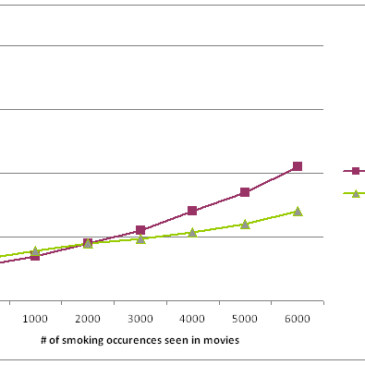Lacking a stable identity and searching outside of the self for acceptance is a combination that makes adolescents an especially impressionable age group often influenced by the messages within their environment. Substantial evidence suggests that exposure to smoking in movies is causally related to the initiation of smoking among U.S. adolescents. However, European youth have more access to movies that feature smoking, as many European countries have less strict regulations for smoking imagery in film (Morgenstern et al., 2013). This week’s ASHES reviews the first longitudinal study to examine the relationship between exposure to smoking imagery in movies and smoking initiation outside the U.S. (Morgenstern et al.,
2013).
Methods
- The currentstudy assessed 9,987 adolescents from a larger study of 16,551 students recruited from more than 100 schools in Germany ,Iceland, Italy, Poland, The Netherlands, and the UK.
- Most (71%) of the sample reported having never smoked at baseline, and those who had were dropped from analysis. Most (85%) of this sample provided one-year follow-up data.
- Measures included:
- Exposure to smoking in movies (baseline):
- Participants rated the number of times they had seen a movie from a list of 50 box office hits in their country.
- The authors counted tobacco occurrences within these movies were counted to determine an individual sum of exposure.
- Covariates (baseline):
- To control for other known risk factors for smoking, participants were screened for many factors such as sociodemographic information, school performance, TV time, and parents’ smoking.
- Smoking behavior (baseline and follow-up):
- Participants reported how many cigarettes they had smoked in their lifetime.
- Exposure to smoking in movies (baseline):
Results
- Researchers found that 17 % of the sample began smoking between baseline and follow-up.
- In all 6 countries, baseline smoking exposure predicted initiation. The risk of initiating smoking increased by 13% for every 1,000 smoking scenes watched. Figure 1 depicts this relationship across country.
- When researchers controlled for variables such as age, gender, and TV time, the relationship between exposure and smoking remained significant in 5 of the 6 countries.

Figure. Relationship between exposure to smoking in movies and adolescent smoking onset before and after adjustments for variables (adapted from Morgenstern et al., 2013). Click image to enlarge.
Note: In addition to the number of smoking occurrences seen in movies, many other variables (such as parental smoking) may affect adolescent smoking initiation. The adjusted model therefore shows the relationship between smoking onset and exposure to smoking in movies after controlling for other variables.
Limitations
- Like most longitudinal studies, this study had some loss of participants between assessments. Those who dropped out of the study might have differed from those who remained in important ways, such as by being more likely to start smoking. If this occurred, this would mean that the percentage from the sample that was able to be analyzed may have shown less smoking initiation than the true sample, and the association between exposure and smoking initiation may likewise have been underestimated.
- Though this study controlled for a large number of variables known to be associated with increased smoking, such as peer influence to smoke, other variables may have influenced the results.
- While this study cannot claim without a doubt that exposure caused smoking initiation, it nevertheless establishes a few criterion for causality, such as temporality (the initiation occurred
after watching the films), strength (the study utilized a large sample size), and consistency (research on this topic from other regions has found the same association).
Conclusions
This study is one of the largest longitudinal studies to examine the relationship between exposure to smoking in movies and smoking initiation in adolescents. The results suggest cross-cultural evidence for the effect of smoking scenes on impressionable adolescent audiences that are still developing their self-image and searching for acceptance. Though smoking may add a dramatic element to cinema, it becomes a public health concern when many adolescents start smoking after watching role models smoke on the screen.
–Melanie Mitchell
References
Morgenstern, M., Sargent, J. D., Engels, R. C.M.E., Scholte, R. H.J., Florek, E., Hunt, K., Sweeting, H, Mathis, F., Faggiano, F., & Hanewinkel, R. (2013). Smoking in movies and adolescent smoking initiation: Longitudinal study in six european countries. American Journal of Preventive Medicine, 44(4), 339-344.
What do you think? Please use the comment link below to provide feedback on this article.




